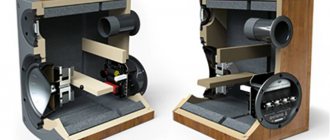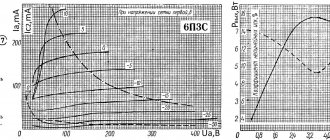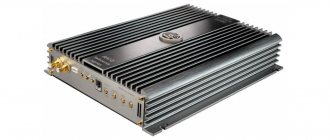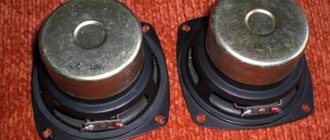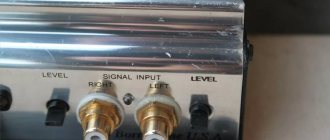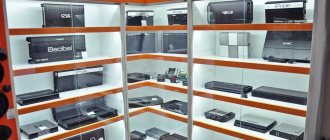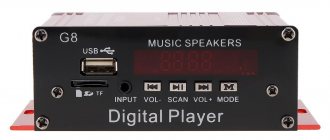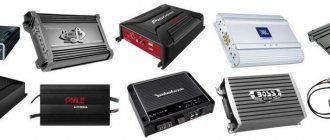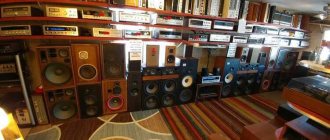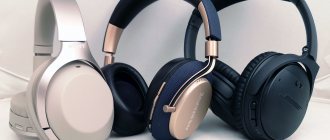Conclusion:
I had a chance to listen to this amplifier and it plays quite well. Subjective and collective reflections have led us to the fact that on 4-ohm speakers (which is the majority of mass-produced cars), this chip is a close analogue of the TDA7851, but at the same time the TCB001HQ has a little more protection against interference.
Additional information:
For the Russian market, the Toshiba TCB001HQ chip is installed in their Android radios:
FarCar S400 series, Daystar Z/ZM series .
What do we have as a result?
The criterion for evaluating sound is highly individual. And if one listener is delighted, it is not a fact that another will like it too. Therefore, you need to listen for yourself, because in the end you will spend most of the time in the car - it’s up to you to choose.
Source
Comparison of amplifiers TDA7851, TDA7850, TDA7560, TDA7388
Sound quality. One of the factors in determining the cost of a car radio is precisely the type of Low Frequency Amplifier chip used in the output stage of the radio (LFA). It is this chip that will mainly affect the sound quality. Of course, the sound is also affected by acoustics, wiring, an external amplifier (if there is one), and much more - but if a cheap ULF was initially used, then no fundamental improvement in sound can be achieved. Therefore, if you are a lover of high-quality sound, before purchasing, be sure to ask what type of microcircuit is used in the radio.
Sound power. Completely depends on the chip used. And the larger this parameter, the better in the end, since the ULF reproduces without distortion only at the beginning of its Amplitude-Frequency Characteristic (AFC) - linear operating mode. This is why they like to install speakers with a resistance of 2 ohms in premium cars.
MOSFET. You can sometimes see this inscription on radio tape recorders. If the manufacturer is not deceiving, then his product uses a ULF microcircuit, which is made using MOSFET technology: two types of transistors are placed on one substrate - bipolar and field-effect. Without going into details, let's say that this symbiosis provides a number of advantages: less heating of the microcircuit, as a result, less parasitic noise, and the absence of high-frequency interference. MOSFET microcircuits have the best signal-to-noise ratio. Below are the main types of ULF chips used by manufacturers in radio tape recorders. This brief description will help you make the right choice based on your sound quality needs.
1. Amplifier TDA 7388 This is a budget microcircuit without outstanding characteristics that can be installed on inexpensive radios. Characteristics: - 4 channels x 41W MAX at 4 Ohm load - THD 4 x 25 W 4 Ohm (14.4 V, 1 KHz) -10%. This amplifier cannot be used in conjunction with premium acoustics with an input impedance of 2 ohms. The amplifier reproduces sound quite mediocre. There are no clear highs and no “softness of the lows” in the sound picture. If you have even a little “sound hearing”, you will not like this ULF model.
2. Amplifier TDA 7560 MOSFET A cheaper analogue of the ULF model TDA7850. It has similar basic characteristics, but is much cheaper in cost. Developed specifically for use in a car. The main advantage is that the chip hardly heats up, the radio with it will last a long time. Installed on all top radios from Daystar. Characteristics: – power 4 channels x 50W/4Ohm MAX. (4x30W/4Ohm 14.4 V, 1KHz, 10%) – power 4 channels x 80W/2Ohm MAX. (4x55W/2Ohm 14.4 V, 1KHz, 10%) Complies with 2Ohm acoustics. It reproduces quite decently, but there is no feeling of “sound transparency”. In general, it has proven itself on the positive side.
3. Amplifier TDA 7850 MOSFET Characteristics: – power 4 channels x 50W/4Ohm MAX. (4x30W/4Ohm 14.4 V, 1KHz, 10%) – power 4 channels x 80W/2Ohm MAX. (4x55W/2Ohm 14.4 V, 1KHz, 10%) – made using MOSFET technology. The amplifier matches perfectly with 2Ohm acoustics. It has a low level of parasitic noise and a high signal-to-noise ratio, which corresponds to the HI-FI class. Gives a rich sound picture. Compared to the TDA7388 chip, the sound is clearer and bassier, with high-quality lows. Installed, for example, on all radios from the manufacturer Kaier.
4. TDA 7851L MOSFET amplifier A further development of the TDA 7850 amplifier, but adapted specifically for use in multi-core car radios. It has identical characteristics to the ULF 7850, but the output power is slightly reduced, due to this the manufacturer has achieved less heat generation in the limited volume of the radio. They try to install such chips on modern power plants to reduce heat generation. For example, an 8-core radio with a frequency of each core of up to 2000 MHz has a stronger processor heating than with 4 cores. Plus, there are standard devices with a thin back part, where heating turns the radio into an “iron”. In this regard, reducing the heat dissipation of each component on the board is a necessity. Characteristics: – power 4 channels x 48W/4Ohm MAX. (4x28W/4Ohm 14.4 V, 1KHz, 10%) – power 4 channels x 72W/2Ohm MAX. – made using MOSFET technology. The amplifier matches perfectly with 2 Ohm acoustics. It also has the highest class AV sound, with a low level of sound distortion and minimized losses. Various types of protection are built-in, including thermal ones; displacement currents between channels are monitored and adapted to changes in the supply voltage. Excellent sound transmission, clear fronts in the low sound segment, no “sound blurring effect” or “frequency sticking together” - all harmonics are clearly pronounced.
The criterion for evaluating sound, of course, is highly individual, and if one listener is delighted, it is not a fact that another will like it too. Therefore, you need to listen for yourself, because in the end you will spend most of the time in the car, so it’s up to you to choose.
l-diodov.ru
Tda7851 or tda7838 which is better
I decided to create a topic for choosing Head Units on the Android OS (hereinafter referred to as GU) and describe in more detail where to start your choice and what to pay attention to.
Q: I saw that the seller Mekede already has Android 11, should I take it?
A: There is no 11th Android for GU yet. Even if you saw the screenshot and your godfather/neighbor bought such a GI. Fake!
Q: I just can’t decide on a radio, how much should I take: 2, 3, 4, 6 GB of RAM?
A: Three rules: - the miser pays twice; - more expensive is not always better; — there are no ideal GIs. 3-4 is quite enough. The RAM memory is filled to a maximum of 2 GB. There is absolutely no point in taking 6 GB unless you are buying in reserve.
Q: What percentage should I take so that nothing lags?
A: You need to consider processors PX6, Spreadtrum (Unisoc) UIS7862 or SC9863a (UIS8581A), Qualcomm Snapdragon 450, AC8257. In general, any 6-8 core processors with 2-4 GB of RAM.
Q: Will there be any slowdowns with 1-2 GB?
A: not really, but sometimes you have to wait so to speak)) Navigation may be delayed in the city. But here it is also worth considering that the amount of RAM is not as important as the performance of the processor. For example, the Spreadtrum (Unisoc) SC9863a (UIS8581A) processor with 2 GB of RAM is faster and more productive than Rockchip PX5 with 4 GB of RAM. 1 GB should not be considered in principle, since the system consumes an average of 1.5 GB of RAM!
Q: I want to buy a GU on a PX6 processor, will there be sound via HDMI?
A: The answer is in the post
Q: I would like some kind of “top.” Recommend the most serious manufacturers!
A: Don't chase brands. Absolutely all manufacturers have problems. Don't forget that this is China!
Q: I want to buy a ZhimBilSun device for $47. Tell me, will it work? I need a radio, rear view camera and sometimes navigation.
A: It will. But as a $47 device. Don't expect sound, stability or quality from it.
B: I don’t have buttons on the steering wheel, so I want a GU with knobs.
A: Not necessarily.
Q: What is the difference between TEYES CC2 Plus, TEYES SPRO Plus, and TEYES CC3?
A: The answer is in the post
Q: Is it possible to install 2 GUs in a car at the same time?
A: Yes >>>
Processor: RockChip PX5/RK3368
(8 cores with a frequency of 1.5 GHz) android 8.1., 9.0., 10. 4 GB RAM, 32/64 memory. Relatively fast and popular (but Yandex is already slowing down). The percent has been tested by users far and wide, has a bunch of firmware, including modified ones (with root rights, flexible settings, full Russian translation, and a bunch of useful things). Forum topics on this process: - MCU MTCD/E/P_ХХХ) - MCU CSN2 (manufactured by Klyde) - MCU TP6735 - MCU S32F0_XinRC; S32F0_LingYun – MCU “Date-Time-KYD-XX”
Qualcomm Snapdragon 450 processor
8 cores 64 bit ARM-Cortex A53 1.8 GHz) Android 10. Built-in DSP module. 95,000 points in the antutu test. Support for SIM cards and a 360-degree view system. A very fresh solution, there are practically no owners in the subject yet. There are no firmware mods for this processor. In my personal opinion, a very good option. Forum thread
You can see other, less popular processors at the link.
Source
Review of audio amplifier chips for car radios.
Review of built-in amplifiers in car radios. Which chips sound better?
Sound quality is one of the most important components when choosing a car radio. In most different radios, the parameters and characteristics are very similar, but the difference in price is very significant. Why? GPS is in everyone, Bluetooth, television and so on are also present. In terms of functionality, all modern car radios are very similar, which makes it difficult for consumers to choose. So, the sound quality of your radio, as well as the price, is directly affected by the type of Low Frequency Amplifier (LF Amplifier) chip. These microcircuits can be very different in characteristics and quality, which affects the cost of the car radio.
In this article we will help you understand these chips. Of course, the sound quality is also influenced by the car’s acoustics, external amplifier (if available), wiring, etc. But the basis of high-quality sound is the ULF chip! If you use a cheap ULF chip, then no matter how you distort it, no matter how sophisticated the acoustics you install, you will not get good and high-quality sound. Based on this, when buying a radio, you should inquire about the type of microcircuit and you are guaranteed high-quality sound.
But there is one caveat. Most car radio sellers do not know which ULF chip is installed in each specific radio. Also, this information is not indicated on the manufacturer’s website. You will be able to find out the output power, in most cases overestimated, and possibly the frequency range that is reproduced - that’s all the information on the sound. In most cases, the manufacturer hides information about the chip used, because... A cheap chip is installed to reduce the cost of the device.
Car radios on the Android operating system are already not cheap, but what if you install expensive Low Frequency Amplifier microcircuits on them? So the manufacturer installs a budget microcircuit so as not to scare off the client with the price. Since the sound power completely depends on the installed chip, we can conclude that the greater the power, the higher the quality of the ULF installed in the head unit.
Sometimes on car radios you can see the inscription - MOSFET. This means that it uses a chip made using MOSFET technology. This microcircuit heats up less; it has two types of transistors on one substrate: field-effect and bipolar. This allows you to reduce parasitic noise and eliminate high-frequency interference. Chips that are manufactured using MOSFET technology provide an optimal signal-to-noise ratio.
To make the right choice, let's move on to a description of the types of microcircuits that developers use in car radios:
Chip TDA 7388
This is the simplest and cheapest microcircuit that is installed in most cheap car radios.
Characteristics:
- 4 channels of 40 W maximum into 4 ohms load
- operating frequency from 20 Hz to 20 kHz (The entire frequency range audible to the human ear)
- THD 4 x 25W 4Ohm (14.4V, 1KHz) -10%.
The sound quality leaves much to be desired; there is no softness at low frequencies, and there is no purity of sound at high frequencies. The sound is satisfactory, so-so. Also, a radio with this microcircuit cannot be connected to premium acoustics, the resistance of which at the input is 2 ohms.
TDA 7850 MOSFET chip
A very good amplifier with high-quality sound, to which you can connect any acoustics.
Characteristics:
- 4 channels of 50W/4Ohm MAX.
- 4 channels of 30W/4Ohm 14.4V, 1KHz, 10%
- 4 channels of 80W/2Ohm MAX.
- 4 channels of 55W/2Ohm 14.4V, 1KHz, 10%
- Manufactured using MOSFET technology
- Excellent matching with 2 ohm speakers
- Hi-Fi class in terms of signal-to-noise ratio
Excellent sound quality at any frequency. There is no high-frequency interference, and the level of extraneous noise is low.
TDA 7560 MOSFET chip
An analogue of the TDA 7850 chip described above, but much cheaper. Since it was developed specifically for use in car radios.
Characteristics:
- 4 channels of 50W/4Ohm MAX.
- 4 channels of 30W/4Ohm 14.4V, 1KHz, 10%
- 4 channels of 80W/2Ohm MAX.
- 4 channels of 55W/2Ohm 14.4V, 1KHz, 10%
- Manufactured using MOSFET technology
- Excellent matching with 2 ohm speakers
- Hi-Fi class in terms of signal-to-noise ratio
The sound is pretty good, but when compared with the 7850, the sound picture is a little less rich.
TDA 7851A MOSFET chip
This chip is a continuation of the TDA 7850 and is designed specifically for car head units. The performance is superior to its predecessor, although the power is slightly reduced to reduce heat generation.
Characteristics:
- 4 channels of 45W/4Ohm MAX.
- 4 channels of 28W/4Ohm 14.4V, 1KHz, 10%
- 4 channels of 72W/2Ohm MAX.
- manufactured using MOSFET technology
- Excellent matching with 2 ohm speakers
- Hi-Fi class in terms of signal-to-noise ratio
The owner of a radio with this chip will get the ideal sound for true music lovers without distortion or loss. This microcircuit is also characterized by a low level of sound distortion with minimal losses and has the highest sound class - AB. There is input voltage control and various types of protection.
Conclusion:
If you are a true connoisseur of sound quality and want to surprise your passengers with bright, rich, high-quality sound, look for a car radio with a TDA 7851A MOS chip
surround.com.ua
Tda7851 or tda7838 which is better
I decided to create a topic for choosing Head Units on the Android OS (hereinafter referred to as GU) and describe in more detail where to start your choice and what to pay attention to.
Q: I saw that the seller Mekede already has Android 11, should I take it?
A: There is no 11th Android for GU yet. Even if you saw the screenshot and your godfather/neighbor bought such a GI. Fake!
Q: I just can’t decide on a radio, how much should I take: 2, 3, 4, 6 GB of RAM?
A: Three rules: - the miser pays twice; - more expensive is not always better; — there are no ideal GIs. 3-4 is quite enough. The RAM memory is filled to a maximum of 2 GB. There is absolutely no point in taking 6 GB unless you are buying in reserve.
Q: What percentage should I take so that nothing lags?
A: You need to consider processors PX6, Spreadtrum (Unisoc) UIS7862 or SC9863a (UIS8581A), Qualcomm Snapdragon 450, AC8257. In general, any 6-8 core processors with 2-4 GB of RAM.
Q: Will there be any slowdowns with 1-2 GB?
A: not really, but sometimes you have to wait so to speak)) Navigation may be delayed in the city. But here it is also worth considering that the amount of RAM is not as important as the performance of the processor. For example, the Spreadtrum (Unisoc) SC9863a (UIS8581A) processor with 2 GB of RAM is faster and more productive than Rockchip PX5 with 4 GB of RAM. 1 GB should not be considered in principle, since the system consumes an average of 1.5 GB of RAM!
Q: I want to buy a GU on a PX6 processor, will there be sound via HDMI?
A: The answer is in the post
Q: I would like some kind of “top.” Recommend the most serious manufacturers!
A: Don't chase brands. Absolutely all manufacturers have problems. Don't forget that this is China!
Q: I want to buy a ZhimBilSun device for $47. Tell me, will it work? I need a radio, rear view camera and sometimes navigation.
A: It will. But as a $47 device. Don't expect sound, stability or quality from it.
B: I don’t have buttons on the steering wheel, so I want a GU with knobs.
A: Not necessarily.
Q: What is the difference between TEYES CC2 Plus, TEYES SPRO Plus, and TEYES CC3?
A: The answer is in the post
Q: Is it possible to install 2 GUs in a car at the same time?
A: Yes >>>
Processor: RockChip PX5/RK3368
(8 cores with a frequency of 1.5 GHz) android 8.1., 9.0., 10. 4 GB RAM, 32/64 memory. Relatively fast and popular (but Yandex is already slowing down). The percent has been tested by users far and wide, has a bunch of firmware, including modified ones (with root rights, flexible settings, full Russian translation, and a bunch of useful things). Forum topics on this process: - MCU MTCD/E/P_ХХХ) - MCU CSN2 (manufactured by Klyde) - MCU TP6735 - MCU S32F0_XinRC; S32F0_LingYun – MCU “Date-Time-KYD-XX”
Qualcomm Snapdragon 450 processor
8 cores 64 bit ARM-Cortex A53 1.8 GHz) Android 10. Built-in DSP module. 95,000 points in the antutu test. Support for SIM cards and a 360-degree view system. A very fresh solution, there are practically no owners in the subject yet. There are no firmware mods for this processor. In my personal opinion, a very good option. Forum thread
You can see other, less popular processors at the link.
Source
High quality 4-channel HI-FI amplifier on TDA7850A | RadioDom
| Lovers of good sound will really like the four-channel HI-FI amplifier on the TDA7850A, the chip is specially created for high-quality audio equipment, and has the following technical characteristics: supply voltage from 12 to 18 Volts, output power for each channel, with a maximum supply voltage of 50 Watts into a 4 ohm load and 80 watts into 2 ohms, harmonic distortion at rated output power of 0.015% and a very low noise level.
|
radiohome.ru
The TDA7388 introduces new four-channel (4 x 45 W) Class AB power amplifier technology for HI-END automotive applications.
Thanks to the fully complementary PNP/NPN structure, the output signal of the TDA7388 can almost reach the supply voltage (Rail to Rail) without the use of a boost capacitor.
PECULIARITIES
- High power output 4 x 45W @ 4R
- Low distortion and minimal output noise
- STD-BY and MUTE functions
- Automatic activation of MUTE mode when low supply voltage is detected
- Minimum external components
- Fixed gain 26 dB
- There is no external feedback and no boost capacitor
- Flexiwatt25 housing
PROTECTION
- Short circuit of the output to the common or supply wire
- Large load inductance
- Crystal overheating
- Load Loss
- Broken common wire
- Polarity reversal
- Static voltage
| Table of maximum values | ||
| Symbol | Parameter | Magnitude |
| VS | Operating supply voltage | 18 V |
| VS(DC) | Supply voltage (chip in standby mode) | 28 V |
| VS(pk) | Supply voltage (pulse t = 50 ms) | 50 V |
| IO | Output current - periodic (D = 10%, f = 10 Hz) - non-periodic (t = 100 µS) | 4.5 A 5.5 A |
| Ptot | Power dissipation (case temperature 70 0C) | 80 W |
| Tj | Crystal temperature | 150 0С |
| Tstg | Storage temperature | — 55 … + 150 0С |
| Rth j-case | Thermal resistance crystal-case (max) | 1 0C/W |
TDA7388 chip pinout
MAIN TECHNICAL CHARACTERISTICS
Test conditions (unless otherwise specified): VS = 14.4 V; f = 1 kHz; Rg = 600 Ohm; RL = 4 Ohm; Tamb = 25 °C.
| Parameter | Test conditions | Meaning |
| Quiescent current | RL = ∞ | 120 - 350 mA |
| Output offset | Playback mode | ±100 mV |
| Voltage surge during on/off | ±80 mV | |
| Voltage Gain | 25 - 27 dB | |
| output power | THD = 10%, Vs = 14.4 V | 26 W (typ) |
| Maximum power output (non-musical) | Vs= 14.4 V Vs= 15.2 V | 41 W 45 W |
| Harmonic distortion | POUT = 4 W | 0.04% (typ) |
| Power supply ripple suppression | f = 100 Hz, VR = 1 VRMS | 50 - 65 dB |
| High cutoff frequency | POUT = 0.5 W | 100 - 200 kHz |
| Input impedance | 70 - 100 kOhm | |
| Stereo separation | f = 1 kHz, POUT = 4 W | 60 - 70 dB |
| Current consumption in standby mode | VST-BY = 0 | 20 uA (max) |
Dependence of output power on supply voltage (RLOAD = 4 Ohm)
ADVICE FOR USE
The figure below shows a typical connection diagram for the TDA7388 chip for use in four-channel mode.
SVR capacitor C6 regulates the turn-on and turn-off timing of the chip, and therefore plays a significant role in optimizing clicks during transients. The minimum recommended value is 10 µF.
The input signal for the TDA7388 is supplied relative to the common wire (ground-compatible inputs) and can reach a peak value of up to ±8 V without fear of damaging the chip. When using 0.1 µF input capacitors C1 – C4, the lower cutoff frequency will be 16 Hz.
To control the ST-BY and MUTE modes, the CMOS pins of the microcontroller or any external low-power transistors can be used. RC circuits (R1C9 and R2C10) are used to smooth the control signals, which prevents any audible clicks from occurring when the chip is controlled.
Since the normal control current for 22 pins (MUTE circuit) is about 10 µA, the maximum value of resistor R2 is 70 kOhm. This fact allows the use of a small capacitor of 1 µF (C10).
For a silent (no click) return of the amplifier from standby mode (ST-BY), the transition voltage speed must be less than 2.5 V/ms. If you do not plan to use the ST-BY and MUTE modes, then the corresponding pins can be connected directly to the power bus.
If parasitic noise appears at the output of the amplifier, a first-order low-pass filter (1 kOhm plus a 220 pF capacitor) should be connected to the input of the microcircuit.
For more detailed information please refer to the factory data sheet.
| Datasheet TDA7388 Rev. 5 (605 KB) |
ANALOGUES (PIN TO PIN)
The table shows microcircuits that have the same pinout (pin-to-pin analogues). Before changing one microcircuit to another, you should carefully study the factory technical description for compatibility.
The author is not responsible for the accuracy of the information on analogues given in this table. Carefully check the compliance of the microcircuits with the technical description.
| IC | Description | Note |
| TDA7381 | 4 x 25W quad bridge car radio amplifier | Difference: Pin 25 - diagnostics |
| TDA7382 | 4 x 22 W four bridge channels car radio amplifier | Difference: Pin 25 is a clip detector |
| TDA7383 | 4 x 30W quad bridge car radio amplifier | Difference: Pin 25 is a clip detector |
| TDA7384A | 4 x 46W quad bridge car radio amplifier | |
| TDA7385 | 4 x 42W quad bridge car radio amplifier | Difference: Pin 25 - diagnostics |
| TDA7386 | 4 x 45W quad bridge car radio amplifier | |
| TDA7387 | 4 x 41W quad bridge car radio amplifier | |
| TDA7388 | 4 x 45W quad bridge car radio amplifier | |
| TDA7389 | 4 x 45W quad bridge car radio amplifier | difference: pin 25 – clip detector |
| TDA7454 | 4 x 35 W high efficiency quad bridge car radio amplifier | difference: 16 pin - switching modes and 25 pin - clip detector |
| TDA7850 | 4 x 50 W MOSFET quad bridge power amplifier | difference: pin 25 - HSD/OD output |
| TDA7851F | 4 x 48 W MOSFET quad bridge power amplifier | difference: pin 25 - OD output |
| TDA7854 | 4 x 47W MOSFET quad bridge power amplifier | difference 25 pin - clip detector output |
| STPA001 | 4 x 50 W MOSFET quad bridge power amplifier | Only in Flexiwatt25 housing. Difference: Pin 25 – OFFSET DETECTOR OUT |
| STPA002 | 4 x 52 W quad bridge power amplifier with low voltage operation | Only in Flexiwatt25 housing. Difference: Pin 25 – OFFSET DETECTOR OUT |
RELATED MATERIALS
- Power amplifier 2 x 100W Mariolla MRL-7293ST
- Amplifier 2 x 120W on STK411-240E
- Power amplifier Mariolla VS-270TD
- Power amplifier 200W based on field-effect transistors Mariolla MOSFIT-200
- Amplifier 2 x 35W on TDA2050 according to ITUN circuit
- Power amplifier 100W Mariolla MRL-7294
- Power amplifier 2 x 35W according to ITUN Mariolla MRL-2050 circuit
- Amplifier 2 x 22 W on TA8210A
- Power amplifier 4 x 45W Mariolla MRL-7388
- Car amplifier circuits based on TDA8561Q
- Chip TDA8561Q (datasheet in Russian)
